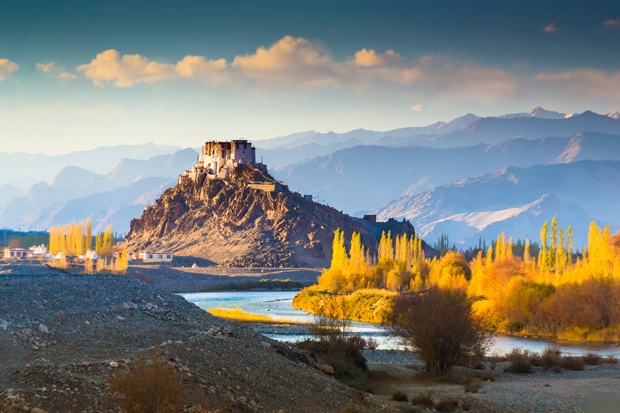Robert Twigger’s father was born in a Himalayan hill resort and carried to school in a sedan chair. His son, born in 1965 and long fascinated by the region, has produced a social and cultural history of the mountains. It is a hybrid volume — and why not? Twigger leaves no mountain path untouched in his bookish reportage.
Topics covered in this long book include crustal formation and destruction, the pre-Buddhist Bon religion (even today 10 per cent of Tibetans are Bon-worshippers), shamans, yeti, Colonel Francis Younghusband (‘the first mountaineer’), altitude sickness (which fascinates Twigger), the 19th-century exploration of Nain Singh, that bloody annoying Madame Blavatsky and much else.
Chapter titles include ‘The Mapping of It’, and ‘Mythical Origins’, in which we learn that ‘Himavant was the ancient ruler of Himalayan India. He was father of Ganga, the river goddess,’ and so on. Other chapter titles — such as ‘The Major is Drowned and to be Auctioned off Today’ — are less guessable.
The author, one of whose previous books is Red Nile: A Biography of the World’s Greatest River, is a solid researcher, a good writer and an amiable companion. The subject matter is dense. It turns out that even the geographical definition of the big mountains is more complicated than I’d imagined. ‘It is excusable to believe that the Himalayas simply provide a north-south barrier,’ explains Twigger. ‘This is true, though less significant than the more formidable east-west barrier they provide.’
Few of the ‘real journeys’ of the subtitle are Twigger’s own. Despite scores of pages on Tibet, he says he didn’t want to go there, as he dislikes travelling in a group (the only way to reach the tabletop, apparently). But it doesn’t matter: White Mountain doesn’t pretend to be a travel book. On the few journeys Twigger does make, he tends to put up in hovels to save money; but in Kalimpong, in West Bengal, he does stay at the legendary Himalayan Hotel, which all the greats visited, including Alexandra David-Néel, Hillary and Tenzing.
As for the ‘imagined journeys’, Himalayan people’s strong sense of the transcendental is inextricably bound up with their surroundings. Twigger does a good job with what he calls ‘the endless complications of Tibetan Buddhist writing’. Then, of course, come the pundits — religiously learned Brahmin. ‘The British invader,’ writes Twigger, commenting not for the first or last time on the terrible imperialist clashes in the region, ‘decided to become a slightly different kind of pundit.’
Each chapter opens with a proverb from the various tribal groups of the zone, some quotes more enlightening than others. Twigger shows respect and compassion for indigenous people’s sufferings as the old world vanishes and they find no place in its replacement — a global story. No foreign nation emerges with credit:
The British were the last to give up on Tibet; in 2008 the foreign secretary David Miliband claimed that it was ‘archaic’ to insist on Chinese suzerainty rather than sovereignty. It was just another deal to make money for Britain; more importantly it meant that China’s invasion had succeeded — Tibet no longer existed as an independent or semi-independent nation.
On a lighter note, I enjoyed the brief and unexpected excursions into the author’s past: ‘I spent a week in the 1990s,’ he announces, ‘teaching aikido to Indian soldiers at a training camp above Dehradun.’ His response to the beauty of a snowy landscape is obviously heartfelt. Twigger has published several volumes of poetry, and one observes a poetic turn in some of his lines here.
Many of the ‘real’ journeys in this book are made by climbers. Twigger is excellent on the rasp of crampon on ice and the headiness of thin air. The unlikeable Reinhold Messner, perhaps the greatest mountaineer ever to have lived, receives much attention. As does, of course, that May day on Everest in 1996 when so many climbers perished, and about which so many books have been written. ‘The movie,’ Twigger writes of the recent major feature film on the disaster, ‘of course gets it wrong.’ He doggedly sifts through the evidence and reaches his own conclusions.
Generally the book drifts west to east, ending up among the Naga on the Indian-Burmese border. White Mountain is more quirky than most others in the field — volumes by Charles Allen and John Keay, for example. I’m not sure if these variegated chapters make a coherent whole, but they are lively, interesting, unusual and entertaining.






Comments